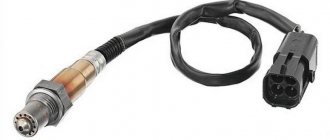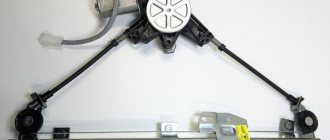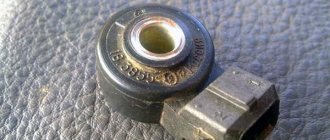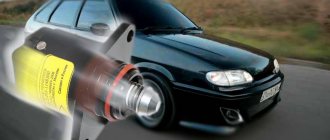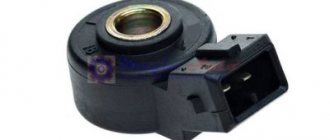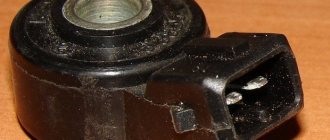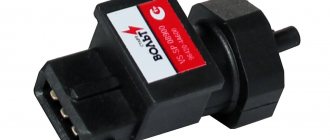The VAZ 2114 car is equipped with a phase sensor. It is necessary to determine the position of the camshaft in relation to the parts of the crank mechanism. Symptoms of a malfunction of the phase sensor on a VAZ 2114 8 valves may differ individually for each case, and in this article we will consider all possible manifestations of this malfunction.
Helpful : How much does a camshaft sensor cost?
Checking functionality
If typical signs of DF failure occur, or if errors 0343 or 0340 are displayed on the on-board computer of the fourteenth, it is necessary to check the functionality of the DF.
This is done using a conventional multimeter. Fourteeners with 16 and 8 valve engines have different DFs, so the specifics of checking them will be slightly different.
- On the first tester probe we set the voltage to 13.5 Volts and connect it to contact “E” on the DF, on the second probe, which must be connected to contact “B” - 0.9 V;
- Having closed the contacts, we bring a metal screwdriver to the end of the sensor. If the DF is working, you will see on the tester screen that the voltage of contact “B” has dropped to 0.4 Volts. If this does not happen, the DF is broken;
- We set the following voltage on the multimeter: contact “E” - 13.5 Volts, “B” - 0.4 Volts;
- We close the contacts and insert a screwdriver into the hole on the phase sensor. If the device is working properly, the voltage at pin “B” will increase to 0.9 Volts.
A multimeter is a standard device for checking the performance of any sensor
Where is the unit located?
The sensor is located on the engine in two versions: on an 8-valve engine it is installed on the cylinder head, and on a 16-valve engine it is installed on the side of the drive camshaft in the area of the generator. It can be easily found and dismantled without visiting a car dealership, although the second option will require more effort and skills.
Phase sensor connector VAZ 2114 (8 valves)
What is Camshaft Position Sensor CMP
Mass air flow sensor signs and causes of malfunction
The camshaft controls the opening and closing of the intake and exhaust valves
The cylinder head of your car's engine contains 1 or 2 camshafts, which are equipped with lobes necessary to operate the intake and exhaust valves. The joint shaft is located in the cylinder block, which, receiving torque from the movement of the pistons in the block, transmits it using gears, a timing chain (or timing belt) to the camshaft.
Camshaft
To determine which engine cylinder is on stroke, your vehicle's computer monitors the rotation position of the camshaft relative to the crankshaft position using the camshaft sensor (CMS). The information received from the CMR sensor is necessary to adjust the synchronization of the spark supply to the combustion chamber and the operation of the fuel injectors. Thus, the camshaft sensor directly affects the fuel consumption of the car and the number of emissions in the exhaust.
The most common camshaft sensors are magnetic and Hall effect. Both types of sensors transmit a voltage signal to the electronic engine control unit or to the vehicle's on-board computer.
The magnetic image of the camshaft sensor produces its own alternating current (sine wave). Typically this sensor has two wires. A Hall effect sensor uses an external power switch to receive a digital signal and usually has three wires.
Camshaft position sensor
Depending on the make and type of your vehicle, your engine may have one or more camshaft sensors. There are also two types of CMP sensors that may be used in your vehicle.
Symptoms of a faulty camshaft sensor
The CMP sensor, like any other part in your vehicle, is subject to wear and tear and will eventually need to be replaced. This will happen in any case once its maximum service life has expired. This usually occurs due to wear on the internal wire wrap or associated component.
In this case, the engine may run rough and the symptoms will vary depending on the type of sensor wear. Thus, the connector in the sensor may wear out, the internal circuit of the sensor, or a related component may fail.
— On some vehicles, if the camshaft position sensor is faulty, the transmission may lock in one gear until you turn off the engine and start it again. This can be repeated with a certain cyclicity.
— If the camshaft sensor begins to work incorrectly while the car is moving, you may feel that the car is moving jerkily, losing speed.
- If the camshaft sensor fails, you may experience a noticeable loss of engine power. So, your car will not be able to accelerate over 60 km/h.
— The engine may stall intermittently due to a faulty CMR sensor
— If the sensor fails, you will notice poor engine performance: loss of dynamism, misfires when turning on the ignition, jolts during acceleration, popping noises in the exhaust system, etc.
— On some car models, if the camshaft sensor is faulty, the ignition spark may disappear entirely, which will ultimately lead to failure to start the engine.
Once your vehicle's computer detects a faulty camshaft position sensor, it will cause a Check Engine light to appear on your dashboard. After detecting poor operation of the CMR sensor, the computer will write the sensor error code into memory. In order to accurately determine the cause of the camshaft sensor malfunction, it is necessary to conduct computer diagnostics of the car by connecting special equipment to the diagnostic connector of the car. Then, using a special computer program, read the error code. Below we present you a table of diagnostic error codes that are associated with wear on the camshaft sensor.
Signs of an error
Where is the fan switch on VAZ 2114 photo?
There are a number of indirect signs by which you can determine that there are problems with the camshaft position sensor or its wiring. The situations described below may indicate other breakdowns, so if they occur, additional diagnostics with an error scanner (for example, the popular ELM 327 device or its equivalent) is needed. So, when a sensor error p0340 occurs:
- Problem starting the engine. Often the p0340 error results in the car simply not starting. Moreover, this can happen both with a cold and warm engine. However, most often this is simply expressed in the fact that when starting the engine you have to turn the starter longer. Naturally, this negatively affects the condition of the car’s battery, and its entire electrical system as a whole.
- Unstable engine idle speed. In some cases, the car simply stalls at idle, so engine operation must be forcibly maintained by pressing the accelerator pedal.
- The engine "troits". That is, misfires are observed in the cylinders. This leads to a loss of power and a change in the sound of the engine.
- Reduced dynamic characteristics of the machine. This is expressed in the fact that the car accelerates poorly, picks up engine speed poorly, and there may be “failures” of the pedal, that is, after pressing the accelerator pedal, acceleration begins within a few seconds. The car may also have poor traction when driving uphill, especially if it is loaded.
- Fuel consumption increases by 10...20%. This situation arises due to the fact that the electronic control unit switches to emergency fuel supply mode, that is, to pair-parallel mode. Accordingly, all the advantages of phased injection are neutralized.
- The Check Engine light on the dashboard activates. Always perform an error scan when activating it. If the signs of failure described above are not observed, but the scanner still produces error code p0340, then you need to check the computer for false positives. That is, simply clear this information from his memory and then see if it appears again.
It is worth noting that the listed changes in the behavior of the car are not so relevant for engines running on gasoline. The loss of power and increase in fuel consumption are not so great. The only inconvenience that can be noted is that the car starts worse, you have to turn the starter for a long time.
But as for cars equipped with gas-cylinder equipment, here the problems described above can manifest themselves “in full.” The loss of power and increase in consumption will be significant. Another trouble will await owners of cars that have modern gas equipment installed, in particular the fourth generation. So, this equipment has its own electronic control unit. And if a phase sensor error 0340 occurs (as the DPRV is sometimes called), there will be a constant disruption of the operating parameters. Because of this, gas-cylinder equipment, firstly, will need to be constantly reconfigured, and secondly, despite all the adjustments, it will still work in a non-optimal mode, consume more fuel and cause the driver problems with loss of power of the car, constantly stall and etc.
conclusions
Checking the camshaft position sensor of the VAZ-2114 is quite easy and simple. Almost every motorist can cope with this task. But, it is still recommended to start diagnostic operations by connecting to the ECU and identifying error codes.
To achieve maximum fuel economy, many injection cars are equipped with a number of special mechanisms, a phase sensor is one of them. Such a device appeared on modern domestic vehicles in 2007 and is still used today. It can be found on Kalina, Ten, Priora and other masterpieces of the Togliatti plant. For those who are not in the know, I’ll tell you right away that it’s impossible to find the device on carburetor cars because it’s simply not there. All because of the vacuum-mechanical principle of ignition timing into which it is impossible to integrate the controller. It is this procedure that our today’s “hero” is responsible for, but first things first. Do you want to know how the VAZ 2114 camshaft position sensor functions and what the mechanism affects? How to identify a device malfunction and fix it? Then you have come to the right place, because this is exactly what we will talk about.
Causes and symptoms of malfunction
You can determine that the phase sensor on a VAZ 2114 has failed by the following malfunctions in the vehicle:
- Gasoline consumption has increased significantly;
- The acceleration dynamics of the fourteenth have worsened, and dips are observed in the engine’s idle speed;
- The engine idles;
- Errors No. 0343 and 0340 are displayed on the on-board computer screen, which indicate that the DF is faulty and the ECU is operating in emergency mode.
The reason why the phase sensor failed can be determined only after dismantling and visual inspection of the device, in some cases - after diagnosing it. As a rule, the main causes of DF failure are as follows:
- A short circuit has occurred on the internal DF circuit;
- Mechanical damage to the device mounting ears, due to which the housing has shifted in the mounting socket;
- The toothed disk on the pulse signal converter has broken;
- The DF was damaged due to the increased temperature of the engine.
If the device breaks down, the ECU starts working solely on the readings of the crankshaft sensor. In this mode of operation, it is impossible to carry out phased fuel injection, as a result of which the brains of the fourteenth switch the engine to twin injection, which results in excessive consumption of gasoline and deterioration in acceleration dynamics.
Repairing the device in most cases is not advisable, since a DF that has once failed is unlikely to work normally in the future.
Fortunately, the cost of the DF is low - the price of a new device is 400-600 rubles, depending on the manufacturer (prices are also relevant for sensors on the VAZ 2115).
Diagnostics of "DPRV"
The first obvious sign of a faulty phase sensor is a hint from the car itself, namely the on-board computer. If a critical error with code 0343 or 0340 appears on the display, you can even remove the sensor, since the system switches to functioning bypassing it. As a result, the “brains” of the car have no idea what is happening with the camshaft, which means that automatic adjustment of the ignition angle does not function. All this leads to the following consequences:
- Unstable engine operation;
- Increased detonation;
- Floating idle;
- Excessive fuel consumption.
The inspection should begin with a thorough visual inspection, for this pay attention to the following points:
- The presence of moisture on the contacts and oxidation - if it is obvious, it is necessary to clean them.
- External damage to the phase sensor.
- No breaks in the electrical circuit.
If the listed symptoms are absent in your situation and there are serious doubts about the true source of the problems, simply disconnect the sensor. If new symptoms appear while moving, then most likely everything is fine with this controller. Of course, you can only say for sure when you replace the device; for this you will have to buy a new one. Considering the quality of our auto parts, the price for such a product, in my personal opinion, is somewhat overpriced. You need to prepare at least three hundred rubles. So, in principle, we have figured out how to check “DPRV”, let’s move on.
Reasons for the error
There are only three main causes of engine error p0340:
- Damage to the camshaft sensor wiring. In particular, we are talking about her breakup. As a rule, the DPRV has three wires - power, ground and signal. Due to certain mechanical damage, they can fray and the signal will stop going through them. Most often this happens at the terminals or at the contacts (the so-called “chips”, connected to the sensor or connectors of the electronic control unit). Another option is damage to the insulation, which causes them to short to the housing or to each other. The result of such a breakdown will be sending incorrect data to the ECU.
- Damage to the camshaft sensor. DPRV is a fairly simple and reliable device, and it rarely fails. However, when a P0340 error code signal is generated, it makes sense to check the camshaft sensor.
- Incorrect operation of the ECU. This is a fairly rare case, since if the electronic control unit partially fails, not only errors p0340 will be observed, but also many others. However, such a situation is possible, for example, if the control unit software was flashed before the error was generated (for example, when tuning the engine, installing gas equipment, etc.). Accordingly, if there were “glitches” in the firmware procedure or the software itself caused malfunctions, then the ECU may not operate correctly. In even rarer cases, the sensor installation may be misaligned or the unit may experience mechanical damage (for example, after an accident).
Sometimes the cause of error p0340 is incorrect installation of the sensor. However, this is a rather rare case, since it only has one seat. Perhaps the fastening is not strong enough (small tightening torque, which is why the sensor can vibrate when driving) or there is a large gap between the working (sensitive) part of the sensor and the so-called rapper - a tooth on the indicator wheel located on the camshaft.
Principle of operation
The DPRV sensor operates on the Hall principle and is capable of determining the position of the camshaft as accurately as possible at different periods of operation by reading pulses. The device transmits the received information to the electronic control unit (ECU). After this, the main controller adjusts the fuel injection for each injector at a certain time. That is, knowing the position of the camshaft, the on-board computer is able to establish a phased supply of gasoline to the cylinders.
Phase sensor DF VAZ 2114, VAZ 2115 malfunctions and replacement
Welcome, friends, to the DIY car repair website. The VAZ 2114, VAZ 2115 phase sensor is one of the main sensors with which the controller calculates engine operating parameters on Russian-made injection engines.
I would like to immediately say that DF is also found on other VAZ brands, such as Ten, Kalina, Priora, and so on, but in this article we are looking at its description using the example of these models.
Phase sensor (DF) VAZ 2114
This sensor detects the position of the camshaft. It is also called DPRV. The DF is installed on 16-valve VAZ units and on eight-valve ones with EURO-3 toxicity standards, since it saves fuel.
For history buffs, phase sensors began to be installed in mass production at VAZ factories in 2007.
Why do you need a phase sensor (PF)?
Before talking about repairs, you need to find out what this sensor is needed for. It determines the operating cycles of the internal combustion engine. The camshaft cams drive the valves, and the DF determines which valve is open.
This is an integrated control unit, that is, it includes a sensitive element and a signal conversion system. There is a Hall element there - data is taken based on changes in the magnetic field.
The converter has a bridge circuit, a converter block, and an output stage. The work is that the DF determines the intake and exhaust phases of the 1st cylinder.
For carburetor engines it is not needed because the spark is supplied at the moment of compression and at the end of the exhaust gases. DPKV is sufficient for this.
Roughly speaking, the VAZ 2114, 2115 phase sensor functions as a fuel injection system. If it breaks down, the work of sparking falls on the crankshaft position sensor. The designs that are used on 16-valve cars differ from eight-valve ones.
Now let's try to explain in simple words how the phased injection system works. It turns out something like this: the DF gives a signal to the electronic engine control system (ECM), and it, in turn, gives a command to inject fuel, while the intake valve begins to open, and after it has opened, air is sucked in and mixed with gasoline to form a mixture.
When not running, fuel can be supplied to two cylinders simultaneously. If there is a breakdown, the on-board computer displays error 0340 or 0343, which indicates a faulty phase sensor.
The following signs may also be observed:
- When the starter rotates for four or five seconds, the engine starts and the check engine light comes on. This means that the ECU is waiting for a signal from the DF and, not receiving it, writes off the data from the crankshaft position sensor.
- Fuel consumption increases quite decently, by 15 percent.
- Self-diagnosis mode does not work.
- Engine dynamics drop.
Phase sensor malfunctions are difficult to determine at home. So its diagnosis needs to be carried out at special service stations, since the equipment for its diagnosis is quite expensive.
How to replace the VAZ 2114 phase sensor yourself.
But replacing it is a very easy job. It is located at the end of the cylinder head next to the air filter.
Replacing the phase sensor begins by disconnecting the power from the battery. In this case, the control unit memory will be reset.
If this is not done, it will continue to operate in the same mode as with a faulty phase sensor. Normal operation will begin after a few engine starts.
The tool that will be needed is just a ten key and sealant. Next, disconnect the wires from the phase sensor and remove it using a key.
The new sensor needs to be coated with sealant, the layer should be small, and it should be left for about five minutes before installation. We install it on the seat and connect the wires.
Next, connect the battery, start the engine and see if the check engine light comes on. If it no longer lights up, then the sensor is installed correctly.
That's all the work was done, as they say, for ten minutes. Yes, the price of the sensor itself is around $15, depending on the region.
Determination of DF failure
If it breaks down, minor problems arise with idle stability; when starting to move, a “tweaking” effect is possible, as well as increased fuel consumption. These symptoms are associated with the failure to receive on-board computer data on the ignition angle at a certain point in engine operation. If there is no signal from the sensor, the control unit enters emergency mode, that is, it begins to work on a predetermined program without a sensor and issues an emergency error “0340” or “0343”.
Is it possible to replace it yourself or prefer a service station?
The first possible solution is to completely replace the sensor.
This is the cheapest option, because the device costs only 270 rubles. This type of work is done by home craftsmen themselves.
But sometimes it happens that replacing the sensor does not solve the problem. This rarely happens. For example, when a controlled gear moves. In this case, you cannot do without the help of professionals. Incorrect installation of the timing belt is another cause of serious malfunctions. The cost of work for specialists varies, it all depends on the specific problem and the location of the repair. But it’s unlikely to cost more than a thousand rubles.
Detailed replacement instructions
If any malfunctions are detected, it is recommended to replace the part immediately. However, the procedure is slightly different for engines with 8 and 16 valves. Let's consider both options.
If the engine is 8 valve
- In this case, the sensor itself is often mounted using only one bolt. It is easy to unscrew using a 10mm wrench.
- After unscrewing the bolt, you can completely dismantle the device. It is necessary to close the connector where it was installed. This will protect against dirt and dust getting inside.
- The last stage is diagnostics of the regulator. If there are traces of dirt on the surface, you need to get rid of them by wiping the surface dry. After this, you can put the device back in place and start the engine again.
If the indicated measures do not help, a complete replacement is carried out. Photo: ytclone.com
About the features of 16-valve engines
The process of removal and replacement in this case has certain differences:
- The sensor is installed under the air manifold and is located next to the camshaft itself. Removing the radiator grille under such circumstances simplifies the job.
- A wrench or socket extension will also become indispensable assistants. You need to unscrew the two main screws that secure the installation position.
- Now you can proceed to checking the functionality of the device. It is cleaned if necessary. Then it is installed in its place. If the problem does not go away, then you should proceed with replacement.
- It is prohibited to use sealants when installing a new device. After all, it always operates in an aggressive environment. At the same time, the temperature on the cylinder head is constantly changing. Because of this, replacement when using a 16-valve engine is slower, although the actions remain approximately the same.
Verification Information
There are also simple recommendations here.
- The easiest option is to connect to a computer and check for ECU errors. After that, all that remains is to decipher the messages that appear. A decision is then made on the appropriate method to correct the fault.
- We connect the wires to the camshaft position sensor connectors. At the next stage, connect the multimeter.
- The check when the previous condition is met is carried out as follows: we need something flat, made of metal. This part is brought to the tip of the sensor. You need to look at the device, study the readings that change.


